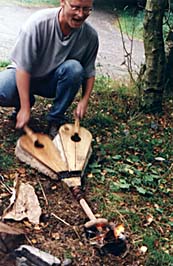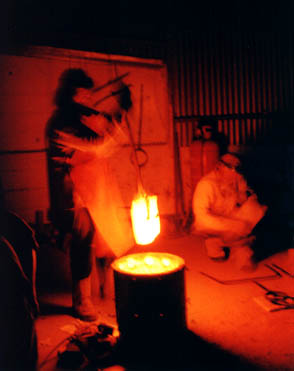|
Umha Aois '99 The aim of the ten-day symposium was to re-create Bronze Age casting techniques using mainly clay and stone moulds, and to empower artists with a hands on approach to bronze casting. This year's project had a strong base to start from drawing on the knowledge and experience from previous projects, which allowed artists to be more experimental in their artistic ideas.
When I arrived at the museum the artists had trekked up to the work site, the barn beside Corradreenan Farmhouse. I joined the group as they walked back to the residential centre, a little row of terraced houses in the museum town area, and was warmly greeted by James Hayes, a project organizer. I immediately knew this was going to be a good ten days. Most of the first day involved setting up equipment and work areas. James, Niall O'Neill, Padraig McGoran and Tina Byrne our team of experts set up a modern furnace to speed things along, and a kiln to fire clay moulds, with the always-helpful hands of George from the museum. Work started carving cuttlefish moulds, a good introduction to the principals of stone carving which meant that everyone made at least one mould this first day, and so bronze was poured. The cuttlefish gave good results and there was a buzz of excitement as these first pieces came out of the moulds. This buzz continued into the next day when everyone eagerly got stuck into making clay moulds. Tina gave advice and showed us how to mix clay with sand, sawdust and manure, ample of which had been supplied by the farmer's horse. The idea was to create porous moulds that would allow gases to escape when bronze was poured into them.
Anders Soderberg arrived from Sweden. An archeologist, he has been studying Scandinavian casting in the Viking age and recreating their techniques. He demonstrated how to make a charcoal pit furnace. A small pit was lined with clay, filled with charcoal and the temperature required to melt the bronze was achieved using a pair of bellows. Once the furnace got going small quantities of bronze could be melted in clay crucibles in about fifteen minutes. It took a lot of hard work on the bellows but everyone who used this small furnace got great results. Anders was very generous in sharing his knowledge of the Viking age, and keen to pick up any tips from the Bronze Age. He used a lost wax method to produce moulds, as he believes was done in the Viking age and produced perfect casts that needed very little finishing. Several other artists used this method. Dympna Molloy was trying to produce some very delicate casts using lost wax, and made some beautifully detailed pieces. While we all kept Tina busy firing clay moulds, Padraig was busy cutting and preparing stones to make two piece stone moulds. These also produced good results. Rosemary Canavan had great success with her axe heads and also made some interesting pieces with such magnificent flashing, everyone agreed it would have been a shame to cut it off. Dave Kinane and Kevin O'Dwyer also did some exciting work. Both experimented with manipulating the bronze to grasp other items such as stones and coins. Dave produced some lovely pieces using clock faces and valves that exploded as the bronze hit, producing interesting results. Kevin pushed the boundaries of mould making with his turf moulds. These caused great excitement as they caught fire when the molten bronze was poured into them, but produced surprisingly good casts with different qualities than those from clay or stone.
As the symposium drew to a close the pace quickened with three or four pours a day, working late into the evening. As dusk fell the noise of the furnace would blaze for about forty-five minutes until the bronze was ready. As this time neared everyone would start to gather round. The green glow from the furnace would die as it was turned off, and the sudden silence would be pressing. The red glow from the crucible lit the sandpit full of moulds, these also glowed red long after bronze was poured into them. The ritual nature of the pour made the whole experience seem magical, and opening the moulds felt like Christmas every time. A challenge was laid down to Umhas Aois by the Ulster museum to produce a core that runs right to the tip of a spearhead as archeologists do not know how this was achieved. Several artists have already produced successful cores and Niall has been perfecting a spearhead. This is a challenge I know Umhas Aois will meet, though everyone agreed ten days was just not long enough. I found this to be the most generous group of artists I have ever worked with, generous in sharing their knowledge skills and ideas which made for an enjoyable and rewarding ten days. We also had a lot of fun together, and everyone went home with plans to make a small charcoal pit furnace in their back gardens. Jo-anne Hatty The Umha Aois Organizing Committee would like to acknowledge (and thank!) all the participants, technicians and facilitators: Rosemary Canavan, Joanne Hatty, Martha Quinn, Sandy Sexton, Maeve McKeogh, Christine Mackey, Fiona Ginnell, Kevin J. O'Dwyer, Patrick Ward, Lorraine Whelan, Annie Hendrichsen, David Kinane, Anders Söderberg, Tina Byrne, Pádraig McGoran, Cliodna Cussen, Dympna Molloy, Niall O'Neill, and James Hayes. We would also like to thank our sponsors: The Ulster Folk & Transport Museum, The Arts Council of Northern Ireland, BOC Gases, Bronze Art Ltd., Cast Ltd., Coldec, P.J. Dix, Isaac Mullen Ltd., Fordham Thermal Systems, James Murphy & Son, RPM, Scarva Pottery Supplies Ltd., Silica Sand Co., and Weldtech. |
||||||||||
|


